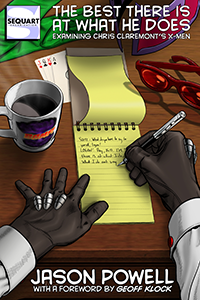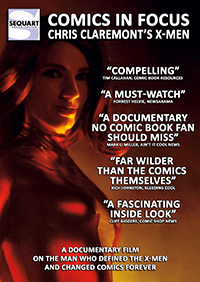The two year gap between Ultimate Wolverine vs Hulk #2 and #3 would become somewhat infamous in the comics community. Ultimate X-Men referenced what Wolverine did, but cleverly alluded to the storyline’s incompletion. Ultimates 3 had an even cheekier reference, with Wolverine decapitating a Hulk-robot and proclaiming: “I kinda wish you were the real Hulk. ‘Cause we have unfinished business.” For a while it was simply assumed that the series had been shelved as one of the incomplete series like All-Star Batman and Robin the Boy Wonder, Daredevil/Bullseye: The Target and Big Numbers. But Lindelof would eventually return to complete the series and there is no major change in the writer’s style in-between issues.
The first page of issue #3 is a highlight of all the events that have happened before. Perhaps this is meant to be an admission to tardiness of the book. The main purpose of the page is to emphasize how unreliable Logan is as a narrator. Within this issue Wolverine changes his mind on what he said to Bruce from “Hi Bruce” to “Hello Brucie.” The omniscient narrator of the issue warns readers that going into Logan’s head means things will be convoluted given his memory being wiped. Lindelof gleefully plays with the familiar format of non-linear storytelling as seen in Lost and this series. Issue #3 is the most conscious attempt to be confusing and non-linear, delivering and playing with audience expectations. The story has countless flash-forwards and flashbacks, delivering surprises and subverting the common held views of fans of the two iconic characters.
Anyone going into a story entitled Ultimate Wolverine vs Hulk will naturally expect the series to be a brutal fight between the two characters. But Lindelof chooses to avoid conventional fighting and instead explores new possibilities with these familiar characters. Being free of the 50-year continuity, Lindelof is able to explore more creatively the extent of Wolverine’s healing factor. Lindelof also is interested in the dynamic possibilities of growth with the Hulk in terms of the Hulk being able to switch from calm and intelligent to brutal and stupid. The first segment of the narrative is an enjoyable exchange between Bruce and Logan about the latter pursuing the former. The exchange is full of dark comedy, pop culture references and genre awareness. Unlike other versions, the Hulk truly has become a menace to none and wishes to be left alone. But Logan is quick to carry a grudge and angrily swears that he will never stop pursuing Bruce, “even if it means sticking a branch up my stump.” What Lindelof creates is an interesting foil where Bruce Banner has made (supposed) peace with his rage and accepted his past sins. In contrast Logan cannot relent in his rage and quickly looks for something to kill to give purpose to his soul-crushing life. What Lindelof see’s is two characters who are embodiments of anger, but it is ironically the Hulk who is able to move past it while Logan cannot.
The story then abruptly shifts backward to explain the cause of the exchange. Lindelof’s Wolverine is as stunned as readers to find an intelligent and articulate Hulk. The exchange even more so than the previous focuses on the issue of the characters anger and their ability or inability to move past it. Banner is much more critical of Logan deciding to kill someone he has never met. Bruce further adds insults by mentioning Logan’s lack of intelligence and alluding to Logan being marked to die by Fury if he ever withdraws from the X-Men. Bruce attempts to deconstruct and even pity Logan. Bruce see’s Logan as a bizarre man whose proclivity towards violence stems from something lacking in his life. This pity cannot overcome a downright disgust at Logan, as Bruce describes Logan as “an animal”. This charge does unnerve Logan enough to attempt go on the offensive and provoke Bruce into fighting.
Logan succeeds in this petty goal by mentioning Betty Ross to Bruce. Despite Bruce’s progress in moving past his anger, he still devolves into the raging Hulk when the subject of Betty is brought up. It’s a natural admission that his one-time fiancé is a person that is difficult to completely let go of. Bruce explodes and immediately proceeds to pummel Wolverine before ripping him in half. Despite fans holding Wolverine in such high-esteem Lindelof subverts the expectation that it would be a fair fight between the eponymous characters. Wolverine is no match for the Hulk’s rage and brute fighting, the actual physical confrontation between the two is hopelessly one-sided and brutally brief. It actually seems hopeless for Wolverine until “Plan B” arrives in the form of She-Hulk.
Issue #4 much like Issue #2 is a long flashback leading up to a brief but critical new development in the overarching storyline. The issue much like the rest of the series plays with reader expectations by having Betty Ross, not Jennifer Walters be She-Hulk. The beginning of the issue once again shows events that have already transpired from a different perspective. Betty Ross realizes Bruce is alive when her lover answers the phone. In the beginning of the storyline Betty seems simply like the passive female character that has unfortunately been prevalent in comics for some time. It cannot be avoided that Betty Ross’ agency in the narrative is motivated by her relationship to Bruce. Motivation of love is not treading new grounds. But Lindelof is able to offer a refreshing and interesting Betty by making her be quick in recognizing an opportunity and manipulating all around her with her intelligence rather than her appearance.
The greater characterization and depth to Jennifer Walters is also a welcome addition to the narrative. As one reads the story one naturally presumes that Walters’ attempts to improve the Hulk serum will lead her to becoming She-Hulk, but her exact motivations prove to differ. Her repartee with Ross is also enjoyable as she is blunt and eager to explore the true potential of her work. Much like The Incredible Hulk’s characterization of The Leader, Walters ignores the possibilities of danger or misuse in her experiments. Her overconfidence is vindicated and she certainly is a loose cannon given that she experimented on a banned genetic serum without authorized approval. Walters’ cockiness is never given the chance to be proven wrong, although she does reveal herself to be a surprisingly passionate Trekkie. Lindelof offers a completely new and different take on Jennifer Walters that still retains a feisty attitude, but is mostly found in her passion for science and Klingons.
Another enjoyable treat for this chapter comes in the heavily ironic scene with Iron Man and Captain America. The two are playing ping-pong while discussing power and government authority. The sequence provides a visualization to their 616-counterparts conflict for power as well as the nature of being a superhero. From inside the game of being a superhero only Captain America and Iron Man can offer options in how to handle Bruce. To win one must either be tenacious as Captain America suggests (as Wolverine is) or change the game entirely as Iron Man obliterates the ball from the game. Tony Stark also reflects cynicism that is rampant throughout the Ultimate Marvel Universe in sarcastically suggesting a superhero registration program for dealing with Bruce Banner. His objection to the program stems from the inability of the government to genuinely control great power. This is an astute observation coming from an arms dealer whose tech is constantly sought for government acquisition. The cheeky irony is that Steve Rogers in the Ultimate Universe see’s the concept of being co-opted by the government is a “good idea”. Considering Captain America’s powers came from a test tube and the government he is much more of a willing protector of the establishment. His vantage of the government is far more docile than the jaded vantage of Tony Stark so naturally a superhuman registration and submission to the establishment is reasonable. But above all Stark emphasizes that Betty cannot understand the superhero mentality as she is “normal” and “[does not] have any idea what it’s like to wield tremendous power.”
In the end Betty Ross falls to the same temptations of her lover. Bruce Banner transformed himself into the Hulk because he “missed being big”[i]. Similarly Ross’ loves being the center of attention and power reflected in her sexual gratification accompanying her transformation to She-Hulk. Ross still is of the mentality that Bruce Banner is ultimately weak and is in dire need of rescue. But her fears and ego were wrong, Banner had defeated Wolverine and was trying to convince Logan to give up the fight when Betty appears. Ultimately Betty Ross comes unwelcome and only serves to anger Bruce into a Hulk rage, with the Hulk angrily declaring, “Betty break Hulk’s heart…now Hulk break Betty!”
[i] The Ultimates























































